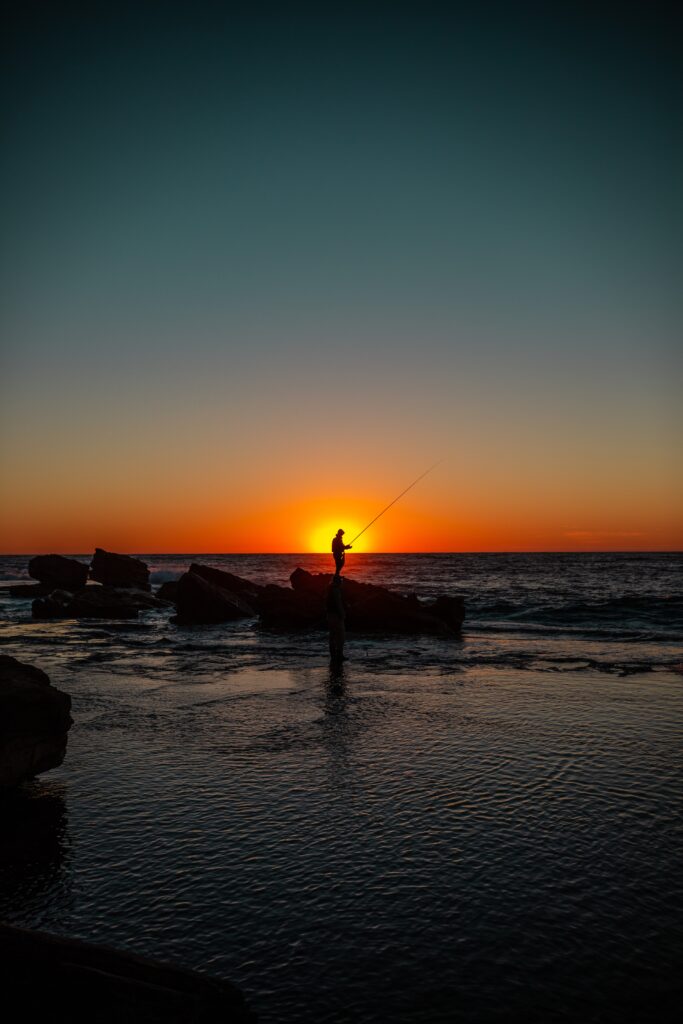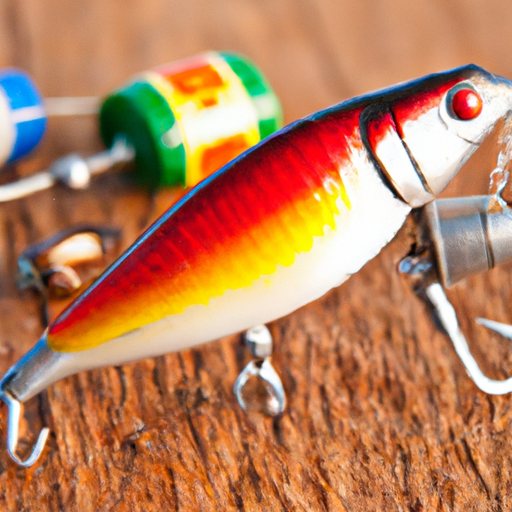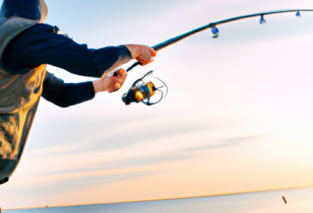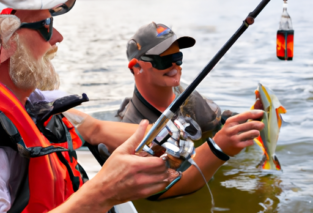In “The Role Of Color In Fishing: Understanding Lure Selection,” you’ll discover the fascinating influence of color on successful fishing. Whether you’re a novice or an experienced angler, this article will provide valuable insights into how different lure colors can attract or repel certain fish species. By understanding the role of color in fishing, you’ll be able to make informed decisions when selecting your lures, giving you a higher chance of landing your next big catch. Exciting discoveries await as we explore the captivating world of lure color in fishing!

Introduction
When it comes to fishing, the importance of choosing the right lure cannot be overstated. Lure selection is not only crucial for attracting fish, but also for enticing them to bite. And one key factor that plays a significant role in determining whether a lure will be effective or not is its color.
In this article, we will explore the impact of color on fish and delve into the science behind color perception in different water conditions. We will discuss how matching the hatch, considering contrast and visibility, understanding species-specific color preferences, and adapting to different fishing conditions can all guide you in choosing the right lure color. So, let’s dive in and discover the fascinating world of color in fishing!
Understanding the Impact of Color on Fish
The Visual Sensitivity of Fish
Have you ever wondered how fish see the world? Fish have a remarkable visual system that allows them to navigate and identify their surroundings. However, their visual sensitivity to color may vary depending on the species and their habitat. Some fish can perceive a wide range of colors, similar to what humans can see, while others have limited color vision.
Color Perception in Different Water Conditions
Water conditions play a crucial role in how fish perceive colors. Factors such as water clarity, depth, and light conditions can significantly influence their ability to see and distinguish different colors. In clear water, fish can perceive a broader range of colors, while in murky or stained water, their color perception may be limited. Understanding these conditions can guide your lure color selection for optimal results.
The Influence of Water Clarity
Water clarity is a vital factor to consider when choosing lure colors. In clear water, lures with natural and vibrant colors tend to be more effective. The clarity allows fish to see the details and nuances of the bait, making it more enticing. On the other hand, in murky or cloudy water, using lures with high contrast colors can help fish better detect and track the bait, increasing the chances of a successful strike.
The Effect of Light Conditions on Color Perception
Light conditions also contribute to how fish perceive colors. Different times of the day and varying weather conditions can impact the availability of light and how it penetrates the water. For example, during bright sunny days, light penetration is greater, allowing fish to see colors more vividly. In contrast, during low-light conditions like overcast days or in dimly lit areas of the water, using lures with bold and fluorescent colors can enhance the visibility and attract fish even in limited lighting.

Matching the Hatch
Imitating Natural Prey
One effective strategy for lure selection is to imitate the natural prey of the fish you are targeting. By observing the local baitfish and insect population, you can get valuable insights into the colors and patterns that are most likely to attract your target species. Matching the hatch not only increases your chances of getting bites but also makes your lure appear more realistic, fooling the fish into biting.
Analyzing the Local Fish Population
To further fine-tune your lure color selection, it’s essential to analyze the local fish population. Different fish species may have specific color preferences based on their natural feeding habits and habitat. By understanding the dominant species in the area, their preferred prey, and the colors that they readily respond to, you can tailor your lure color choices accordingly, increasing your chances of success.
Considerations for Different Seasons and Locations
Remember that the natural environment is not static, and the colors that are most effective may change with different seasons and locations. During spring and summer, when the water is warmer, fish tend to be more active, and using brighter and more vibrant lure colors can be effective. In contrast, during fall and winter when fish are more sluggish, using more subdued and natural colors may yield better results. Additionally, different regions may have distinct color preferences, so it is crucial to consider these factors when selecting your lures.
Contrast and Visibility
The Importance of Contrast
Contrast plays a significant role in the visibility of lures underwater. Fish can detect objects that stand out from their surroundings, making lures with high contrast colors more noticeable and enticing. By choosing colors that contrast with the water and the natural environment, you can increase the visibility of your lure and make it more eye-catching for fish.
Choosing Colors to Enhance Visibility
To enhance the visibility of your lure, consider colors that have a high contrast with the background. For example, using a brightly colored lure in murky water can make it more visible to fish. On the other hand, in clear water, using lures with natural and subtle colors can help them blend in with their surroundings, making the bait appear more realistic and increasing the likelihood of attracting nearby fish.
Factors Affecting Visibility in Different Water Types
Different water types may require different lure colors to achieve optimal visibility. In murky or stained water, where visibility is limited, using lures with bright or fluorescent colors can help fish quickly spot the bait. In clear water, where fish can see more clearly, using lures with natural colors that closely resemble their prey can be more effective. Understanding the impact of water type on visibility will guide your lure color choices for different fishing conditions.

Color Preferences of Different Fish Species
Understanding Species-Specific Color Preferences
Each fish species has its own unique color preferences based on their natural feeding habits and physiology. For example, predatory species like bass may be attracted to lures with contrasting colors to simulate injured prey. In contrast, species that primarily feed on vegetation, like carp, may respond better to lures with natural and earthy colors. By understanding the color preferences of your target species, you can increase your chances of success.
Case Study: Bass Fishing and Color Selection
Bass fishing is a popular sport that often relies on selecting the right lure color to entice bites. Different factors can influence bass color preferences, such as water temperature, light conditions, and the availability of natural prey. During warmer months, bass are more aggressive and may respond well to lures with bright or metallic colors. In colder months or low-light conditions, using darker and more natural colors can yield better results. Experimenting with different color combinations and patterns can help you find the most effective color options for bass fishing.
Traits and Characteristics That Influence Color Preferences
Certain traits and characteristics of fish can influence their color preferences. For example, fish with a more aggressive nature may be attracted to brighter and more vibrant colors, as these colors can trigger their instinct to strike. In contrast, passive fish may respond better to more subdued colors that closely resemble their natural prey. By considering the specific traits and characteristics of the fish you are targeting, you can make informed choices about lure colors to increase your chances of success.
Attracting Aggressive vs. Passive Fish
Selecting Colors to Trigger Aggressive Strikes
If you are targeting aggressive fish species or want to trigger aggressive strikes, using vibrant and attention-grabbing lure colors can be effective. Bright colors like red, chartreuse, and orange can stimulate an aggressive response from fish, as these colors often resemble wounded or injured prey. By selecting these colors, you can provoke aggressive fish into striking your lure.
Using Subdued Colors to Entice Passive Fish
On the other hand, if you are targeting passive fish or fishing in challenging conditions, using more subdued and natural colors can entice bites. Passive fish may be less likely to chase after a brightly colored lure, so using colors that mimic the natural prey of the fish can increase your chances of success. Earth tones, greens, and browns can be effective in imitating the colors of vegetation or smaller fish, enticing passive fish to bite.
Varying Lure Color to Adapt to Changing Fish Behavior
Fish behavior can change throughout the day or in response to environmental factors. By varying your lure color selection based on the behavioral patterns of the fish, you can adapt to their changing preferences and increase your chances of success. For example, during low-light conditions or when fish are less active, using darker and more natural colors can be more effective. When fish are more aggressive or during brighter periods, using brighter and contrasting colors can trigger strikes.

Experimenting with Color Combinations
Using Multiple Colors in One Lure
Being experimental with lure colors is a great way to discover what works best for different fishing conditions. Using lures with multiple colors can create a more enticing and realistic bait. For example, using a lure with a combination of white and red can mimic an injured fish, attracting both aggressive and passive fish. By experimenting with different color combinations, you can find the most effective combinations for attracting fish.
The Role of Fluorescent Colors
Fluorescent colors can play a significant role in attracting fish, especially in low-light conditions or stained water. These colors have vibrant pigments that stand out underwater and can be easily seen by fish. Using lures with fluorescent colors, such as chartreuse or neon pink, can increase visibility and draw fish towards your bait. However, it’s important to remember that the effectiveness of fluorescent colors may vary depending on the species and the specific fishing conditions.
Patterns and Color Blends for Optimal Results
In addition to experimenting with different colors, considering the patterns and color blends on your lure can enhance its effectiveness. Mimicking the patterns of natural prey, such as stripes or spots, can make your lure appear more realistic and increase the chances of attracting fish. Color blends, such as combining natural earth tones with brighter contrasting colors, can create an enticing and appealing presentation that fish find difficult to resist.
The Influence of Fishing Conditions
The Impact of Water Temperature
Water temperature is a vital factor that affects fish behavior and their response to lure colors. Different fish species have preferred temperature ranges and may exhibit different feeding patterns based on water temperature. In warmer water, fish tend to be more active and aggressive, which may influence their color preferences. Cooler water temperatures may require more natural or subdued colors to entice bites. Considering the water temperature when selecting your lure colors can greatly improve your chances of success.
Adjusting Color Selection Based on Water Depth
Water depth can also affect lure color selection. As you fish in different depths, the available light and visibility can vary. In shallow water, where there is more light penetration, using brighter and more vibrant colors can be effective in attracting fish. In deeper waters, where light is limited, lures with high contrast colors can help fish spot your bait. Adapting your lure color selection based on the water depth will optimize visibility and increase your chances of getting bites.
Adapting to Weather Conditions and Light Intensity
Weather conditions and the intensity of light can significantly impact lure color effectiveness. Bright and sunny days provide better light penetration, allowing fish to see colors more vividly. During these conditions, using lures with natural colors that resemble the prey can be effective. In contrast, during overcast or low-light conditions, using brighter or fluorescent colors can increase the visibility of your lure and attract fish. Adapting to the weather conditions and light intensity will give you an advantage in catching more fish.

Practical Tips for Choosing Lure Colors
Considering the Target Species and Their Habitats
Consider the specific fish species you are targeting and their natural habitats when selecting lure colors. Different fish species have distinct color preferences and are accustomed to specific color patterns in their environment. By researching the typical prey of the target species and choosing lure colors that closely resemble those patterns, you can increase your chances of attracting fish.
Observing Local Fishing Reports and Insights
Fishing reports and insights from local anglers can provide valuable information about the most effective lure colors in your area. Local knowledge can help you understand the feeding habits of the fish and the color options that have been successful in the past. Pay attention to reports that mention specific lure colors and the conditions under which they were used. Incorporating this information into your lure selection process can greatly enhance your fishing success.
Experimenting and Keeping Track of Successful Color Choices
Experimentation is key when it comes to lure color selection. While the general guidelines discussed in this article can be helpful, every fishing situation is unique, and fish behavior can be unpredictable. Keep track of your fishing trips, noting the lure colors you used and the results you achieved. Over time, you will start to identify patterns and trends that can guide your future lure color choices. Don’t be afraid to try new colors and combinations, as you never know what may trigger a fish to strike.
Conclusion
Color selection is a critical factor in successful lure fishing. By understanding the impact of color on fish, analyzing the local fish population, considering contrast and visibility, and adapting to different fishing conditions, you can greatly improve your chances of catching more fish. Remember to observe the species-specific color preferences, experiment with color combinations and patterns, and tailor your color selection to trigger the desired fish behavior. With these insights and a little bit of experimentation, you’ll be well on your way to becoming a more successful angler. So, next time you head out to the water, choose your lure colors wisely and enjoy the thrill of reeling in that big catch!





